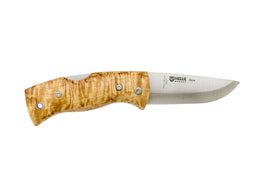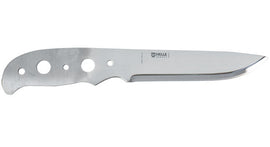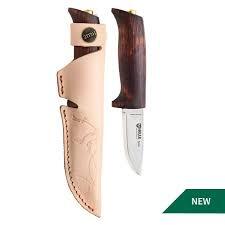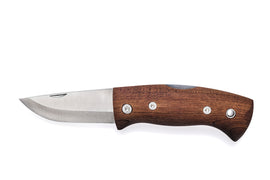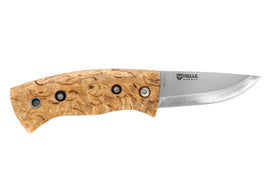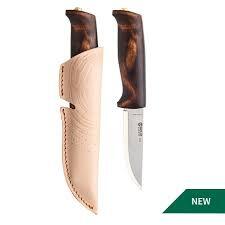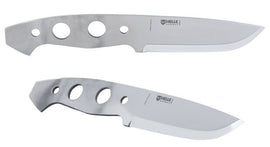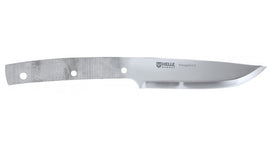BRAND
Shop By Info - Helle Knives

Steinar Helle returned to Holmedal in the late 1920s. As many Norwegians, he had travelled to America after WWI in order to see the world and explore its opportunities. Amidst the hustle and bustle of the “roaring 20’s” that was taking place at the time there was something about the stillness of western Norway that he missed. When Steinar made the decision to return home, he brought with him from America the understanding that skills and ideas coupled with the energy to see it to the end created an opportunity to try something special Even in the wilderness of the Norwegian west. While Steinars story was writing itself, another journey was unfolding. The journey of his brother. Sigmund had spent the past decade learning the temperament of steel from their father, Bernd. Their father was the village blacksmith a vital trade in rural Norway. Later taking this passion further by exploring the craft of steel at the forefront of metallurgy in large Norwegian steel plants. When finally, the two journeys merged they decided they wanted to make a tool.
When looking through the local community it became apparent that most of the knives used by the farmers in their day-to-day lives could be vastly improved and made to a much higher standard. At the same time, the local farmers also had an ornamental “dress knife” that would adorn their belt in church on Sundays. So the brothers set out to bring those two worlds together. A knife that would do the heavy work around forest and farm, but high quality and artistic enough to wear to the most formal occasion. From that day in 1932, the measure of a good Helle knife isn’t just functionality and durability but just because a tool is these two things doesn’t mean it can’t be beautiful too. A company had begun to take shape that would set a new standard in Scandinavian knife production. Steinar and Sigmund pursued these goals relentlessly based on the mindset that something half done is not done. It is easy to see the determination shared between the two brothers when visiting the old workshop located on the family farm. Following the stone paved water channels on the mountain hillside, built by the brothers themselves to harness the snow and rain that naturally ran of the surrounding mountains to power the factory where it sits today.
Besides determination and inspiration, you also need to know how to interact with a wider audience when you make a tool you hope will help people across the world. Sigmund being the engineer worked on developing production, Steinar, armed with the experience of his travels saw the opportunities to help Helle expand. By the 1940s the brothers targeted international markets. A transition that can be physically witnessed on the Helle knives of the period as they begun to mark them proudly in English “Made in Norway”. While Holmedal today might be the smallest knife capital in the world, we still hope that our way of life and philosophy in how to create products can serve as a lantern in todays society. Our products look and feel the way they do today because Helle has always been about not just introducing Holmedal to the world, but the world to Holmedal. Maintaining tradition and principles while always being open to new ideas has defined Helle. Affected by the tides of history and changes in the world that every company with a true heritage share. The Helle family along with its craft people have worked hard to keep production at the factory in Holmedal. Remaining true to those original beliefs.

Helle-Lappland 214mm S/S Blade, Birch handle
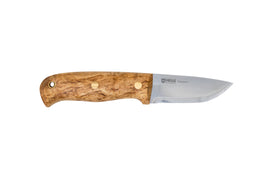
Helle-Wabakimi, triple laminated steel, 84mm blade, curly birch handle. Les Stroud designed

Helle-Utvaer,102mm drop point Sandvik 12C27 stainless steel, curly birch & vulcan fibre handle

Helle-Myra -Limitd Edition- curly birch & walnut with red leather spacers handle. 72mm triple laminated blade.
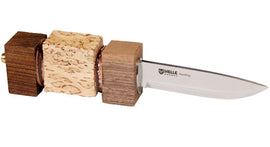
Helle-Harding Partly Finished- Carve your own handle

Helle-Gaupe. Triple laminated stainless steel blade 107MM. Curly Birch handle amd leather sheath

Helle- Fjellkniven 100mm triple laminated full tang blade,curly birch handle, pouch style sheath

Helle-Fiskekniven 155 mm S/S blade, birch handle





